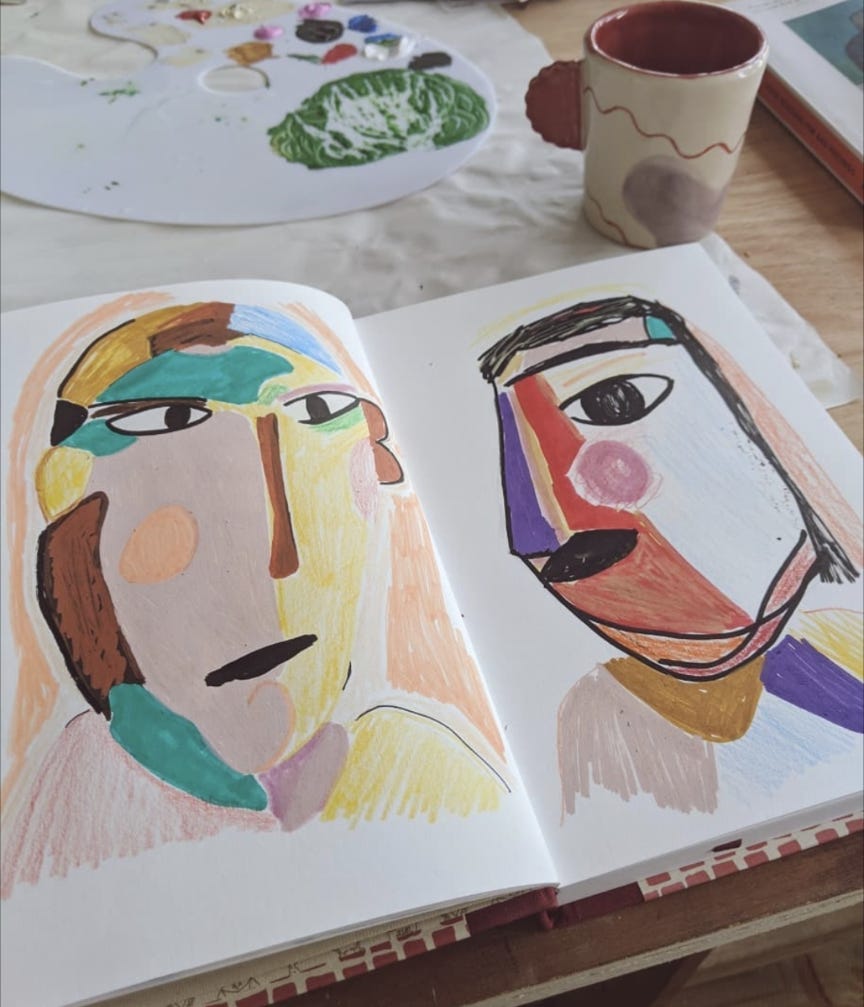short notes #10
notable things, recently: understanding why one of my favourite artworks makes me so emotional, thanks to pliny the elder
For our anniversary in April, my boyfriend bought me a copy of the beautiful catalogue published for a Lucien Freud exhibition a few years ago, New Perspectives. (Massive shout out to Michael's secondhand bookshop in Ramsgate and their wonderful selection of art tomes.) It has gorgeous reproductions and lots of interesting writing. In her catalogue essay, Portraiture and the Nostalgic-Melancholic Souvenir, Maria H. Loh writes
In Pliny the Elder’s Natural History (XXXV.43.12), we hear how the daughter of the Corinthian potter Butades traced the shadow of her lover's face, thrown upon a wall by the lonely light of a candle, as he slept on the eve of his departure. When he was no longer there, she would have a souvenir of him to keep before her eyes and hold close to her heart. Painting was thus invented by a precocious teenage girl, a nostalgic-melancholic who understood that the body will inevitably disappear, but art is forever.
As a woman highly prone to nostalgic-melancholia (Loh defines nostalgia as looking backwards for the source of an emotional wound1, melancholia as looking forward, anticipating “the sting that will nick the heart”), who was once an even more nostalgic-melancholic teenage girl, I love the idea that it was one of us who invented painting!
The essay goes on to reflect on the nostalgic-melancholic nature of Freud's painting Hotel Bedroom, and this immediately made me think about one of my very favourite artworks, Peter in Carennac by David Hockney.
A line drawing of his then lover, Peter Schlesinger, every time I see this picture I get visibly emotional. Weird, because it doesn't involve animals, which are the only things I normally get sentimental about. But there is such an obvious tenderness and love in this very intimate portrait. Viewing it in the context of nostalgic-melancholic portraiture offers a new understanding of why it has such an impact on me. Hockney and Schlesinger would continue to date for a few more years after this picture was made, but when they broke up, it's my understanding that Hockney took it the hardest. Regardless of the specifics of their relationship, though, by the very nature of life and death, when you're preserving the image of someone you love how can you not be aware of the ultimate impermanence of the actual body in front of you? Oof.
In Haley Nahman's essay Xanax for the human condition, she writes about feeling nostalgic for a time before it's even over - premature mourning for the loss or end of an experience whilst you're still living it. I suffer from / am guilty of this in quite an extreme way — it's quite distressing, honestly. I spoil holidays for myself by feeling blue about their approaching end from about day 2. And I feel like this is captured in the nostalgic-melancholic framing — documenting a loved one who is right in front of you but whose eventual loss, whether because their life comes to an end or just your relationship with them, is present in the portrait, imbuing it with premature nostalgia. It's an act of trying to stop time, and you can't.
In ‘artist note’ #5, I wrote about copying a painting, as good practice and to spark your own creativity, and I said that I hadn’t yet attempted it myself. Then in my reading this week, I came across mention of Alexj Von Jawlensky and it reminded me that I have done it, a few years ago, with one of his incredible faces.

I'm going to do some more soon, I think, because they are so much fun to copy and also to play with, making your own versions. Recommend!
Finally, this week I have become completely captivated by the work of Gabriele Münter, like Jawlensky a member of Der Blaue Reiter. Here is one of her paintings to finish.
Or as the wonderful Catherine Cohen puts it, “I love nostalgia. It hurts and feels bad. Boop.”






